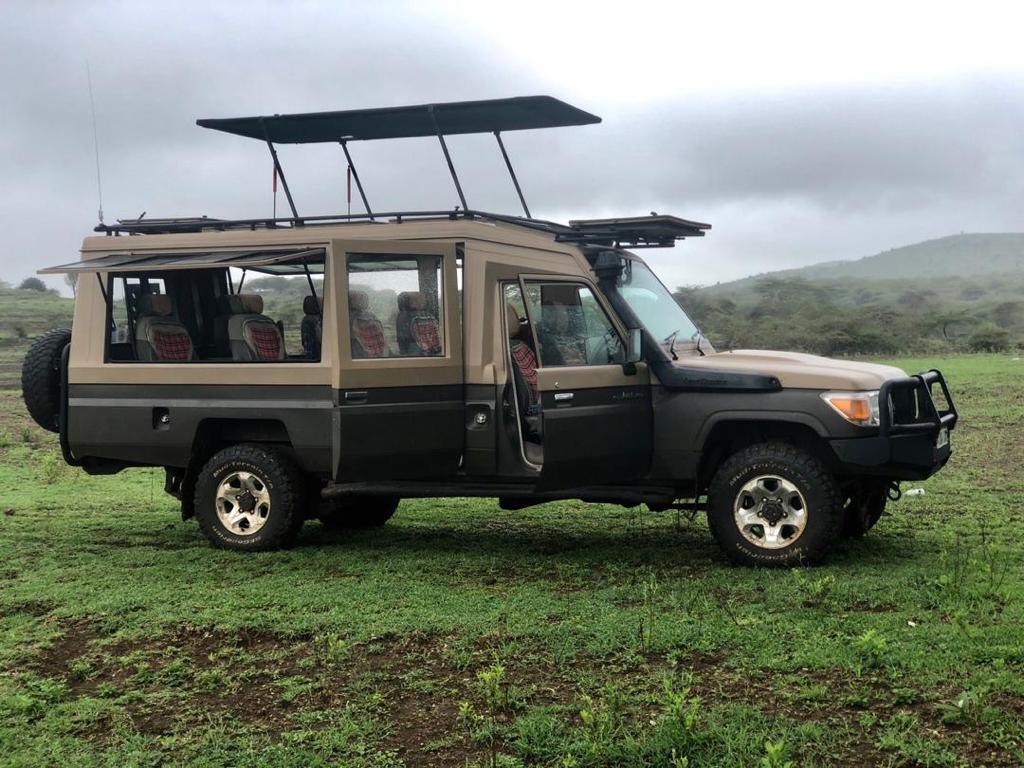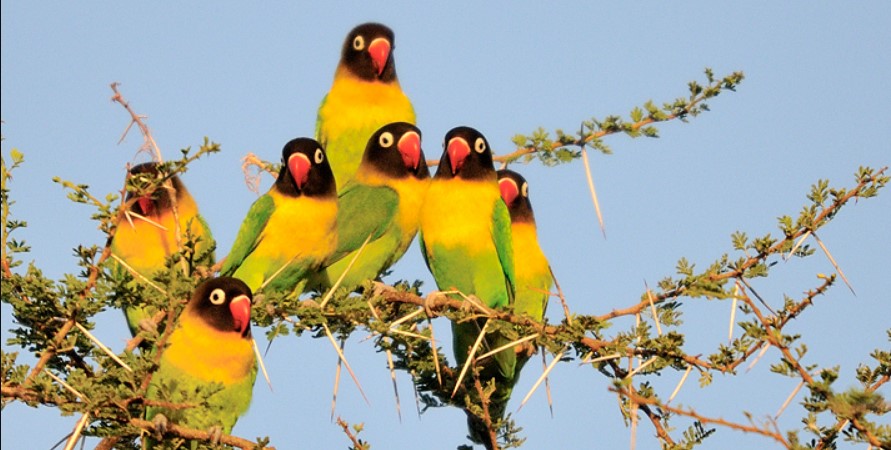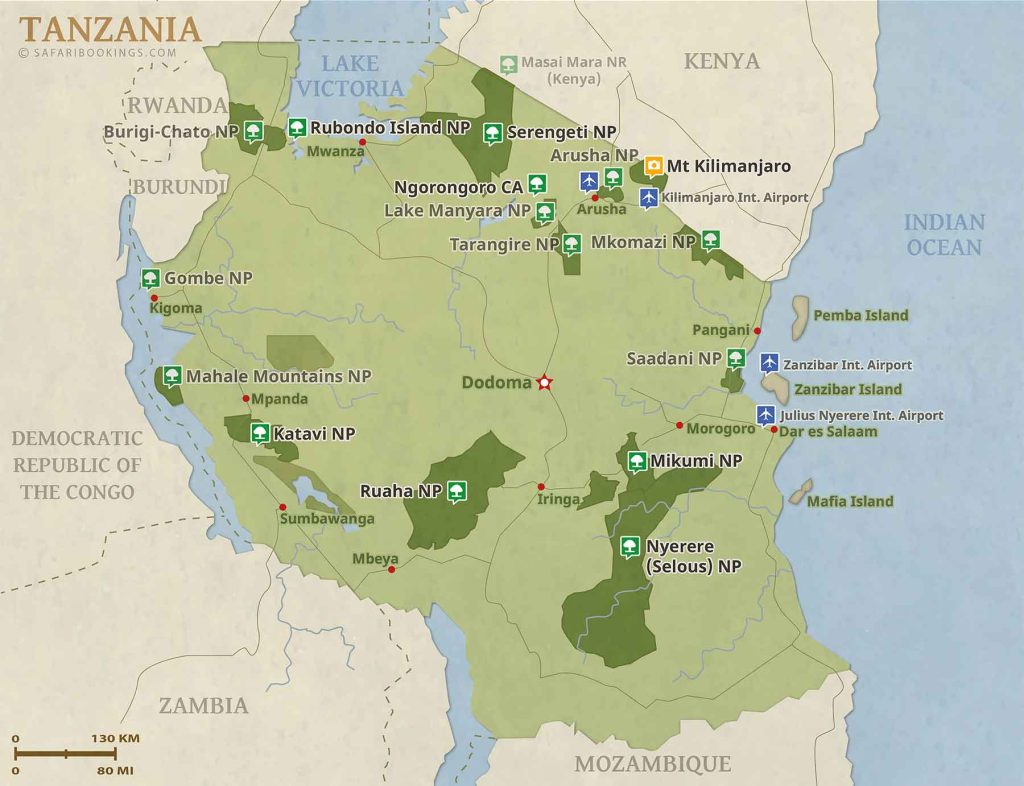Birding Safaris in Northern Tanzania
|
|
|
|
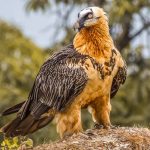 Bearded Vulture – Lammergeier (Gypaetus barbatus)
|
Mount Kilimanjaro & Arusha
Private Birding Safaris:- The inclines of Kilimanjaro are held in forest somewhere around 1500m and 3000m, with both woodland and snow capped bird species occurring here. Enjoy the first day of your Tanzania Safari exploring the vegetation of Arusha National Park & wetlands of Ngurdoto Crater, in the shadow of Mount Kilimanjaro. A percentage of the fowls you can hope to see are recorded on the right.
amazing wetlands & water birds
Ngurdoto Crater
|
| Common: |
|
| Bateleur |
Terathopius ecaudatus |
| Lesser Flamingo |
Phoeniconaias minor |
| Maccoa Duck |
Oxyura maccoa |
| Martial Eagle |
Polemaetus bellicosus |
| Saddle-billed Stork |
Ephippiorhynchus senegalensis |
| Silvery cheeked Hornbill |
Bycanistes brevis |
| Trumpeter Hornbill |
Bycanistes bucinator |
|
|
| Unusual or endemic* to region: |
| Alpine Chat |
Cercomela sordida |
| Lammergeier* |
Gypaetus barbatus |
|
|
|
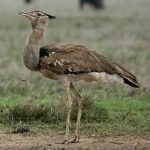 Kori Bustard – (Ardeotis kori)
|
Ngorongoro Conservation Area
Private Birding Safaris:- The Ngorongoro Conservation Area (NCA) is World Heritage recorded and a Biosphere Reserve. The range is embodied the famous Ngorongoro Crater – the world’s biggest unbroken caldera –the Crater highlands; a chain of wiped out and given way volcanoes and the eastern piece of the Serengeti Plains.
Enjoy and exploring the different scope of territories that occur here, from wetlands and alkaline lakes to timber-lands and open fields. The zone is home to more than 550 types of bird species, most of them are endemic. Listed on the right are some of the fowls that you can hope to see.
Jackson’s Widowbird
“From January to April, this friendly feathered creature changes from being a little dreary employment into a dull, long tailed winged bird that moves about quickly to pull in a mate.
Jackson depicted the tricks… as ‘a really ludicrous sight’: guys set up a little zone in long grass in which they more than once bounce around, with hops getting great more than 50cm in stature. They move like this throughout the day, most eagerly in the early morning and late evening.”
David Andrew/ Susan Rhind
Viewing Wildlife East Africa
|
| Common: |
|
| Egyptian Vulture |
Neophron percnopterus |
| Greater Flamingo |
Phoenicopterus rubber |
| Grey Crowned Crane |
Balearica regulorum |
| Hamerkop |
Scopus umbretta |
| Kittlitz’s Plover |
Charadruis pecuarius |
| Kori Bustard |
Ardeotis kori |
| Lesser Flamingo |
Phoeniconaias minor |
| Ruppell’s Griffon Vulture |
Gyps rueppellii |
|
|
| Unusual or endemic* to region: |
| African Water Rail |
Rallus caerulescens |
| Fischer’s Lovebird* |
Agerpornis fischeri |
| Jackson’s Widowbird* |
Euplectes jacksoni |
| Northern Anteater Chat* |
Myrmecocichla aethiops |
|
|
|
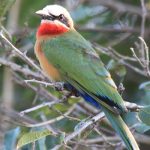 Little Bee-Eater (Merops pusillus)
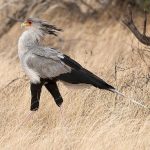 Secretary Bird (Sagittarius serpentarius)
|
Serengeti Plains
Private Birding Safaris:- This most famous and celebrated National Park in Africa is Tanzania’s largest at almost 15,000km2. The Serengeti consists of vast, seemingly endless grass plains in the south-east of the park, punctuated by twisted, solitary acacia trees and large kopjes. In the western corridor where the Grumeti River runs, there are riverine forests, hills, valleys and plains.
Whilst it is most famous for its million strong Great Wildebeest Migration, the Serengeti is also home to over 500 bird species. The highest bird numbers and diversity occurs from October to April. Some of the birds that you can expect to see here are listed on the right.
Vast Grass Plains
Riverine Forests, Hills & Valleys
Over 500 bird specie
Secretary Bird
“Standing 1.2m high & striding up to 20km a day, this high stepping bird is unique to Africa. It kills its prey with a rain of swift kicks from thick, powerful feet and snakes are stamped to death in a lethal flamenco.
Its body & head resemble those of a large eagle, but other traits suggest a common ancestry with storks.
Courtship flights are very raptor-like and include graceful swoops from great height in a “pendulum display” as well as tumbling in mid-air with feet outstretched towards each other.”
David Andrew/ Susan Rhind
Watching Wildlife East Africa
|
| Common: |
|
| Common ostrich |
Struthio camelus |
| Chestnut weaver |
Ploceus rubiginosus |
| Little bee-eater |
Merops pusillus |
| Malachite kingfisher |
Alcedo cristata |
| Marabou stork |
Leptoptilos crumeniferus |
| Pin-tailed whydah |
Widua macroura |
| Secretary bird |
Sagittarius serpentarius |
| Superb starlings |
Lamprotornis superbus |
|
|
| Migrants: |
| Caspian Plover |
Charadrius asiaicus
May-Aug |
| European Roller |
Coracias garrulous
Oct-Apr |
| Levaillant’s Cuckoo |
Oxylophus levaillantii
Oct-Jun |
| Montagu’s Harrier |
Circus pygargus
Oct-Apr |
| White Stork |
Ciconia ciconia
Feb-May |
|
|
| Unusual or endemic* to region: |
| Fischer’s Lovebird* |
Agapornis fischeri |
| Grey-breasted Spurfowl* |
Francolinus rufopictus |
| Rufous-tailed Weaver* |
Histurgops ruficaudus |
|
|
|
|
Birding Safaris in Southern Tanzania
|
|
|
|
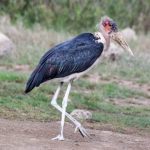 Marabou Stork (Leptoptilos crumeniferus) |
Ruaha National Park
Private Birding Safaris:- Ruaha presently is the largest National park in Tanzania after Usangu Game Reserve being added, Ruaha is more or less unknown and less visited and generally untouched wild. It is found on a dry focal level, and is limited by the Mzombe River to the north and the Ruaha River to the south.
The natural life and vegetation found in this move zone is an extraordinary mix of Eastern (Acacia-Combretum) and Southern (Crachystegia) African species. The Park incorporates riverine vegetation and baobabs that give hollows to numerous bird species. There are more than 400 types of bird species , and during your time in the this park you can hope to see some of the birds recorded on the right.
Untouched wilderness
Vegetational transition zone
Stately Baobabs
|
| Common: |
|
| Brown Parrot |
Poicephalus meyeri |
| Marabou Stork |
Leptoptilos crumeniferus |
| Pale-billed Hornbill |
Tockus pallodirostris |
| Pink-backed Pelican |
Oelicanus rufescens |
| Purple-crested Turaco |
Tauraco porphyreolophus |
| Red-billed Buffalo Weaver |
Bubalornis niger |
| von der Decken’s Hornbill |
Tockus deckeni |
|
|
| Unusual or endemic* to region: |
| Ashy Starling* |
Lamprotornis unicolor |
| Eleonora’s Falcon |
Falco eleonorae
Oct-Nov |
| Yellow-collared Lovebird* |
Agapornis personatus |
|
|
|
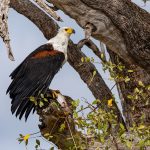 African Fish Eagle (Haliaeetus vocifer) |
Selous Game Reserve
Private Birding Safaris:- Despite the fact that Selous Game Reserve is little known, it has been World legacy recorded and is one of the biggest ensured regions in Africa at more than 50,000km2. The Reserve comprises of plains punctuated by slopes and periodic rough outcrops cut by the relentless Rufiji River; the banks of the waterway progressively offer path to the rough precipices of the staggering Stieglers’ Gorge. The bunch of tributaries structure a system of lakes and tidal ponds, joined by channels of water.
The highlights of this park incorporate the boat and walking safaris, both of which take into account bird watching perception from an alternate point of view. With more than 440 bird species recorded in Selous, some of the bird types you can hope to see are recorded on the right.
Biggest African Game Reserve
Relentless Rufiji River
System of Lakes & Lagoons
Strange Boat Safari |
| Common: |
|
| African Palm Swift |
Cypsiurus parvus |
| African Fish Eagle |
Haliaeetus vocifer |
| Brown-headed Parrot |
Poicephalus crptoxanthus |
| Common Squacco Heron |
Ardeola ralloides |
| Crowned Hornbill |
Tockus alboterminatus |
| Dickson’s Kestrels |
Falco dickinsoni |
| Green wood-Hoopee |
Phoeniculus purpureus |
|
|
| Unusual or endemic* to region: |
| African Skimmer |
Rynchops flavirostris |
| Pel’s Fishing Owl |
Scotopelia peli |
| White-backed Night Heron |
Gorsachius leuconotos |
|
|
|
|
Birding Safaris in Zanzibar & Coastal Area
|
|
|
|
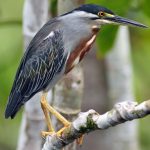 Striated Heron
(Butorides striatus)
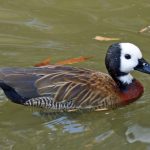 White Faced Whistling Ducks (Dendrocygna viduata) |
Coastal Forests
Private Birding Safaris:- The coastal area of both Tanzania & Kenya are rich ecologically, profoundly differing and home to more than 450 types of bird species. The coast incorporates thick woods, shrubberies, mangroves, stream bays, saltpans, tidal mudflats and seaward islands. The area is hence of real significance for some aquatic birds, including migratory waders. During your time on the terrain drift, some of the birds you can hope to see are recorded on the right.
More than 450 types of fowls
Naturally Rich & Highly Diverse
Forests & Mangroves
Stream Inlets, Saltpans, Tidal Mudflats
Seaward Islands |
| Common: |
|
| Osprey |
Pandion haliaetus |
| Palm-nut Vulture |
Gypohierax angolensis |
| Striated Heron |
Butorides striatus |
| Water Thick-Knee |
Burhinus vermiculatus |
| Wattled Starling |
Creatophora cinerea |
| White-faced Whistling Duck |
Dendrocygna viduata |
|
|
| Migrants: |
| Curlew Sandpiper |
Cakidris ferruginea
Aug-May |
| Grey Plover |
Pluvialis squatarola
Sep-May |
| Little Stint |
Calidris minuta
Aug-May |
| Terek Sandpiper |
Xenus cinerus
Aug-April |
|
|
| Unusual or endemic* to region: |
| African Water Rail |
Rallus caerulescens |
|
|
|
|
|
|
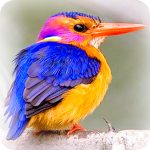 African Pygmy Kingfisher (Ispidina picta)
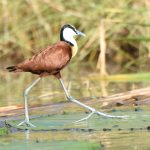 African Jacana (Actophilornis africanus) |
Zanzibar Island
Private Birding Safaris in Tanzania & Zanzibar Beach – Zanzibar Island is well known all over the world for its spices and exceptional coral reefs. With more than 200 bird species on the island, there is a different scope of avifauna here, including both endemic species and subspecies. There are two IBAs here and both are essential for water birds, for example, terns and waders.
The indigenous Jozani Forest Reserve is the only forest at present and is home to more than 40 bird species including a few endemic bird types. Amid your time in Zanzibar, you can hope to observe some bird species as listed on the right.
Flavor & Coral Island
Indigenous Forests
Endemic Species & Subspecies
Water bird asylum |
| Common: |
|
| African Jacana |
Actophilornis africanus |
| African Pygmy Kingfisher |
Ispidina picta |
| Common Greenshank |
Tringa nebularia |
| Crab Plover |
Dromas aedeola |
| Dark-backed Weaver |
Ploceus bicolor |
| Dimorphic Egret |
Egretta dimorpha |
| East Coast Akalat |
Sheppardia gunningi |
| Mangrove Kingfisher |
Halcyon senegaloides |
| Sooty Gull |
Larus hemprichii |
| Whimbrel |
Numenius phaeopus |
|
|
| Unusual or endemic* race: |
| Fischer’s Turaco* |
Tauraco fischeri |
| Grey Sunbird* |
Cyanomitra veroxii |
| Little Greenbul* |
Andropadus virens |
|
|
|
|
|
|
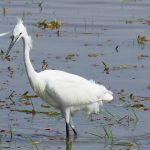 Little Egret
(Egretta garzetta) |
Pemba Island
Private Birding Safaris:- Pemba lies on the north of Zanzibar Island and around 50km off the Tanzania mainland. Regardless of its closeness to Zanzibar, it experiencing few visitors and generally it remains remote. The biggest remaining patch of woodland, Ngezi forest, has a lavish wilderness like shelter with thick cover on the woods floor and is home to four endemic species.
The close-by Misali island is sheltered in forest and our disengaged shoreline retreat is encompassed by mangrove woods. Amid your time on Pemba island, you can explore these territories and hope to see some of the bird species species recorded on the right. |
| Common: |
|
| African Fish Eagle |
Haliaeetus vocifer |
| Bat Hawk |
Macheiramphus alcinus |
| Brown-headed Parrot |
Poicephalus crptoxanthus |
| Little Egret |
Egretta garzetta |
|
|
| Unusual or endemic* to Pemba : |
| Pemba Green Pigeon* |
Treron pembaensis |
| Pemba Scops Owl* |
Otus pembaensis |
| Pemba Sunbird* |
Cinnyris pembae |
| Pemba White-eye* |
Zosterops vaughani |
|
|
|


